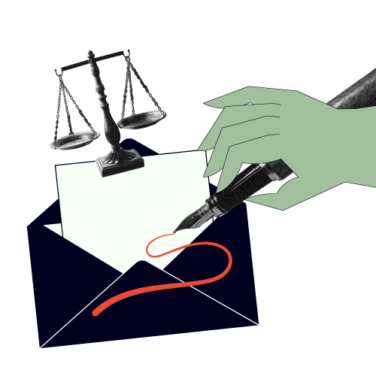“Legal hold notice” isn’t just another piece of legal jargon—it’s an integral part of the litigation process, making it critical for growing law firms to have the right policies in place.
In this guide, I’ll break down the intricacies of legal hold notices and the vital role they play in the legal process. I’ll walk through best practices and practical recommendations on how and when to issue these notices. The goal is to turn this often daunting aspect of litigation into a manageable part of your law practice.
So if you're looking to beef up and optimize hold notice procedures in your law practice or legal department, you’re in the right place.
What Is a Legal Hold Notice?
A legal hold notice (or a litigation hold notice) is an official communication initiated when litigation is on the horizon. Its purpose is to inform all potential custodians that all relevant evidence (paper files, archived documents, electronic data, transcripts of phone calls, and other physical records) related to ongoing litigation or impending litigation needs to be preserved.
The Basics of a Legal Hold Notice
Typically a part of the discovery process, a legal hold notice helps to ensure all potential evidence and communication related to a legal matter remains unaltered and accessible throughout the legal proceedings.
The legal requirements surrounding the litigation hold notices are outlined in the Federal Rules of Civil Procedure.
Failure to comply with legal hold obligations can sway the outcome of a case and have serious consequences for your firm.
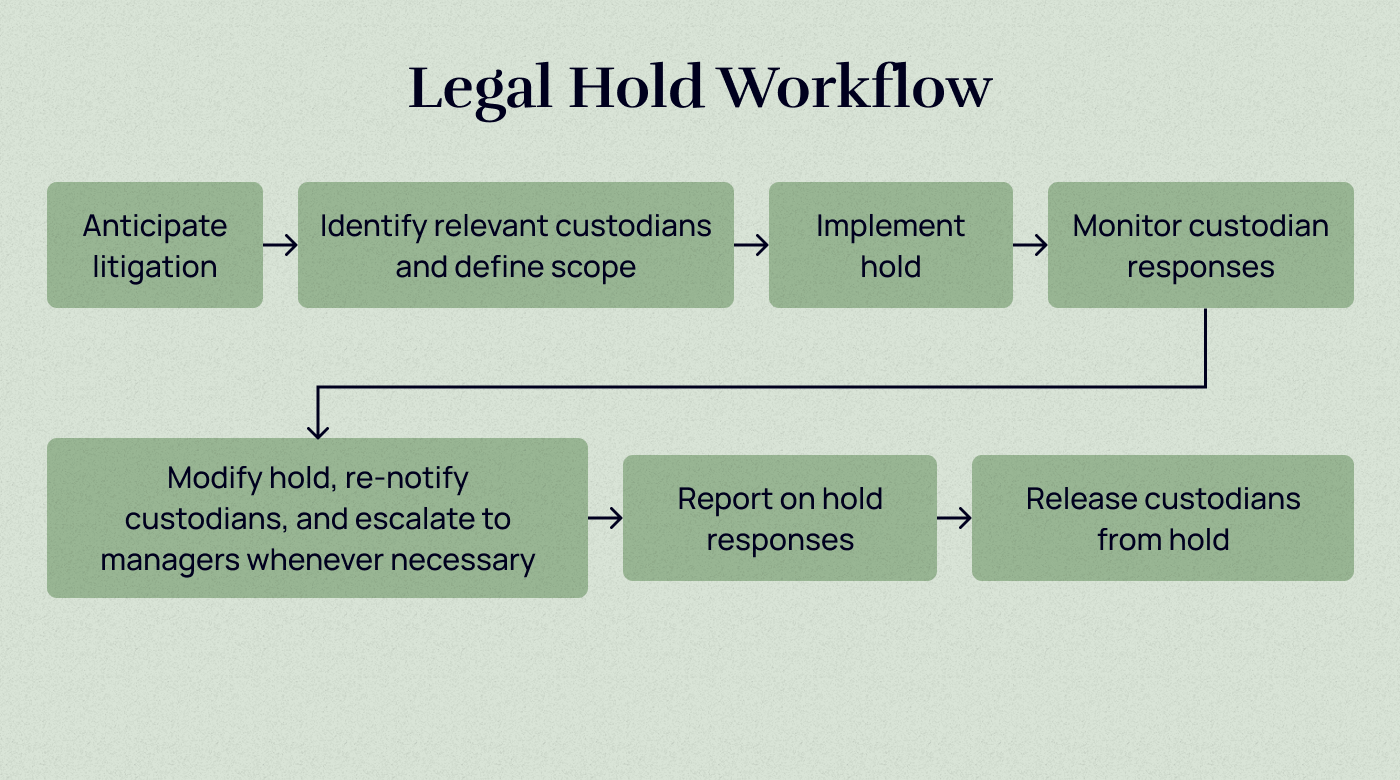
The legal hold process usually unfolds in the following sequence:
- The prospect of legal action or litigation is present
- Individuals who might hold relevant data are pinpointed
- The legal hold notice is issued with instructions not to alter, delete, or destroy affected documents or potentially important information.
The Consequences of Ignoring a Legal Hold Notice
Let’s be clear—neglecting or mishandling legal hold notices can land your firm in hot water.
Imagine a situation where an individual, perhaps due to oversight or, worst-case scenario, malicious intent, destroys relevant documents after receiving a legal hold notice. This action, which is called spoliation of evidence, is a big red flag in the legal domain. It can skew the outcome of the case and lead to monetary sanctions, fines, or even default judgments against your firm.
While this might sound dramatic, it’s not an exaggeration.
Take the landmark Zubulake v. UBS Warburg case. Zubulake won a $29 million settlement after the court decided that UBS Warburg was responsible for the deliberate spoliation of evidence in a gender discrimination case.
So as you can see, following the regulatory guidelines of a legal hold notice is crucial. In the upcoming sections, I’ll delve into the depths of the legal hold process, from understanding triggers to identifying relevant custodians, drafting and issuing the notice, and setting up an effective legal hold policy.
Understanding the Legal Hold Process
Before writing your first legal hold notice, it’s important to know the steps of the process. From the spark that initiates a legal hold notice through identifying the right players and crucial documents, we’re about to navigate it all. And crafting a notice that hits all the marks? You’re about to learn that, too, along with tactics for handling those radio-silent custodians.
And let’s not forget about wrapping up a legal hold neatly and designing a bulletproof policy. This isn’t just about ticking boxes; it’s about solidifying a process that can help your organization maintain compliance with a critical component of the legal process.
When to Send a Legal Hold: Spotting the Triggers
Whether you’re opening your own practice or you’re a partner at a reputable firm, the legal hold notice is a critical component of litigation. Sometimes, you’re the one issuing it, and other times, you’re on the receiving end. It’s a two-way street with the same goal—preserving relevant data and documents in the face of potential litigation.
The first step in this process is recognizing the triggers.
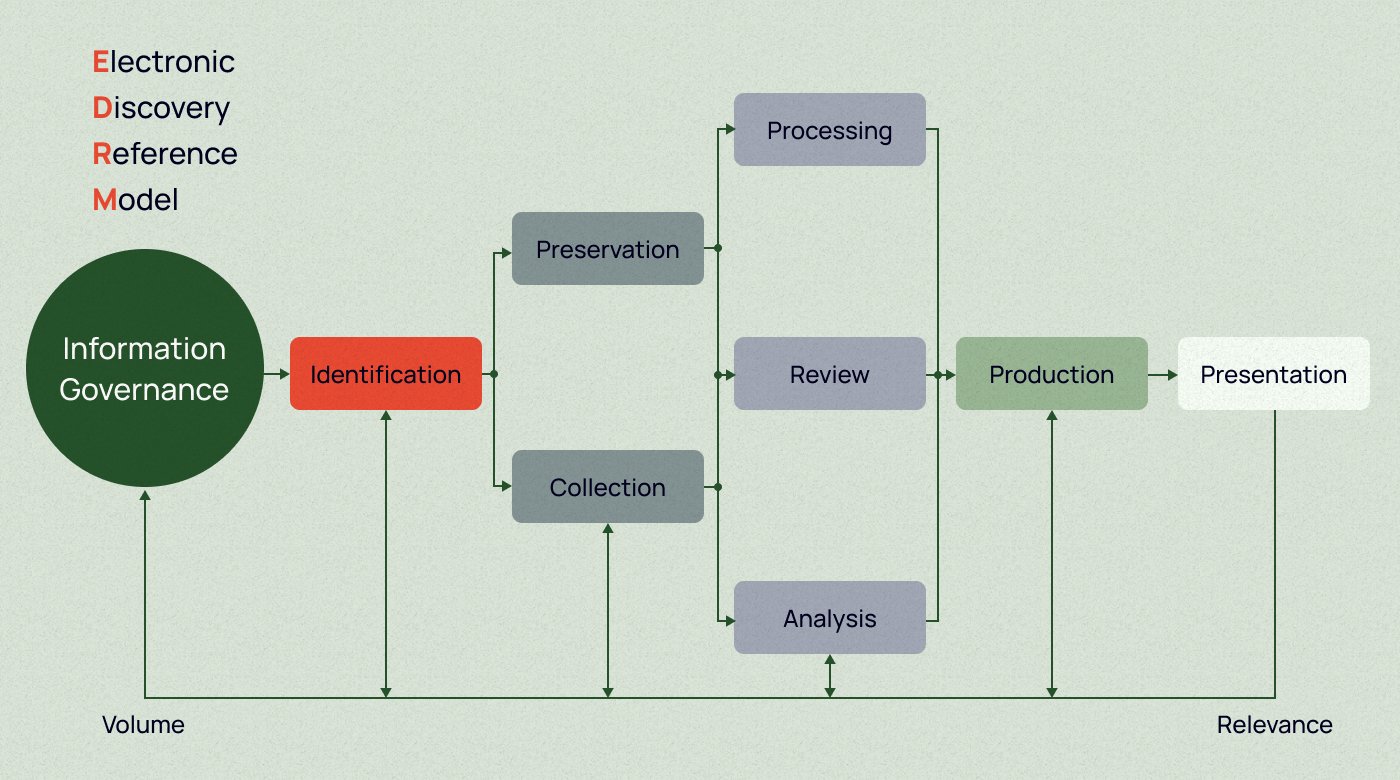
Triggers aren’t always flashing neon signs announcing a lawsuit. Sometimes they’re more subtle, silently hinting at a legal dispute brewing on the horizon. Whispers of a “reasonably anticipated” dispute can signal it’s time to issue or act on a legal hold notice.
But what does “reasonably anticipated” litigation mean? The definition depends on each case. It’s possible that the trigger could be an official lawsuit. However, a trigger might come much earlier than a lawsuit. The key to litigation being “reasonably anticipated” is the credibility or likelihood of a threat—the possibility of litigation needs to be certain.
If a company or firm sends a demand letter or cease-and-desist letter, it's reasonable to believe that litigation is on the horizon. The same idea applies to subpoenas and clear breaches of local regulation.
You might be inclined to brush these triggers aside, waiting until an official lawsuit lands on your desk. But in the legal arena, early action is key. Neglecting these signals could lead to spoliation of evidence—a destructive nightmare that can derail your litigation efforts.
Understanding the triggers for a legal hold notice isn’t just a nice-to-have skill. It’s a must-have for any law firm owner. It’s about keeping your firm ahead of potential litigation and navigating the complex legal landscape with confidence and preparation.
Identifying Relevant Custodians and Documents
When a potential legal dispute triggers a legal hold notice, your next task is to identify relevant custodians and documents. These “custodians” are individuals who may hold key information tied to the matter at hand.
But don’t be fooled into thinking that only high-level executives or direct employees fit the custodian bill. Custodians can come from any corner—an intern who drafted a project report, a receptionist privy to a casual client conversation, or even an IT specialist who maintains server backups can be custodians.
Once you’ve established the “who” comes the hunt for relevant documents. Don’t get tied down by the term “document”—it’s a broad umbrella. Documents can include emails and memos about the project, a contract stored in the obscure recesses of a file cabinet, text messages, or anything exchanged over, or stored on, your company network. Even that sticky note with client feedback stuck under your keyboard counts. Anything and everything related to the case is up for grabs.
Yes, it’s a bit like playing Sherlock Holmes, sifting through information to find those nuggets of evidence. But remember: In the legal world, it’s all about the details. And these details could impact the outcome of a case.
Creating and Issuing the Legal Hold Notice
Putting together a legal hold notice is another key piece of the process. This step is all about clear, direct communication with your custodians, so it requires precision.
When you draft the notice, it’s important to create a briefing that anyone in your firm (or elsewhere) can understand. For instance, instead of saying, “Pertinent data pertaining to the ongoing case needs to be preserved,” try “Pertinent data pertaining to the ongoing case (this includes any emails, documents, notes, or other correspondence related to the case) needs to be preserved” The clearer you are, the more likely that all the documents relevant to the case will be preserved.
Then, define the scope of the investigation. Be as specific as possible as you highlight the documents and data types to preserve. Don’t forget to emphasize that altering or deleting potential evidence isn’t just frowned upon—it’s illegal.
Your notice also needs to have a sense of urgency. Since the routines of the organization keep moving, employees can easily put the notice to the side to work on later. But, as you know, the stakes are high, and the clock’s ticking. Make sure your custodians know that swift action isn’t optional—it’s critical.
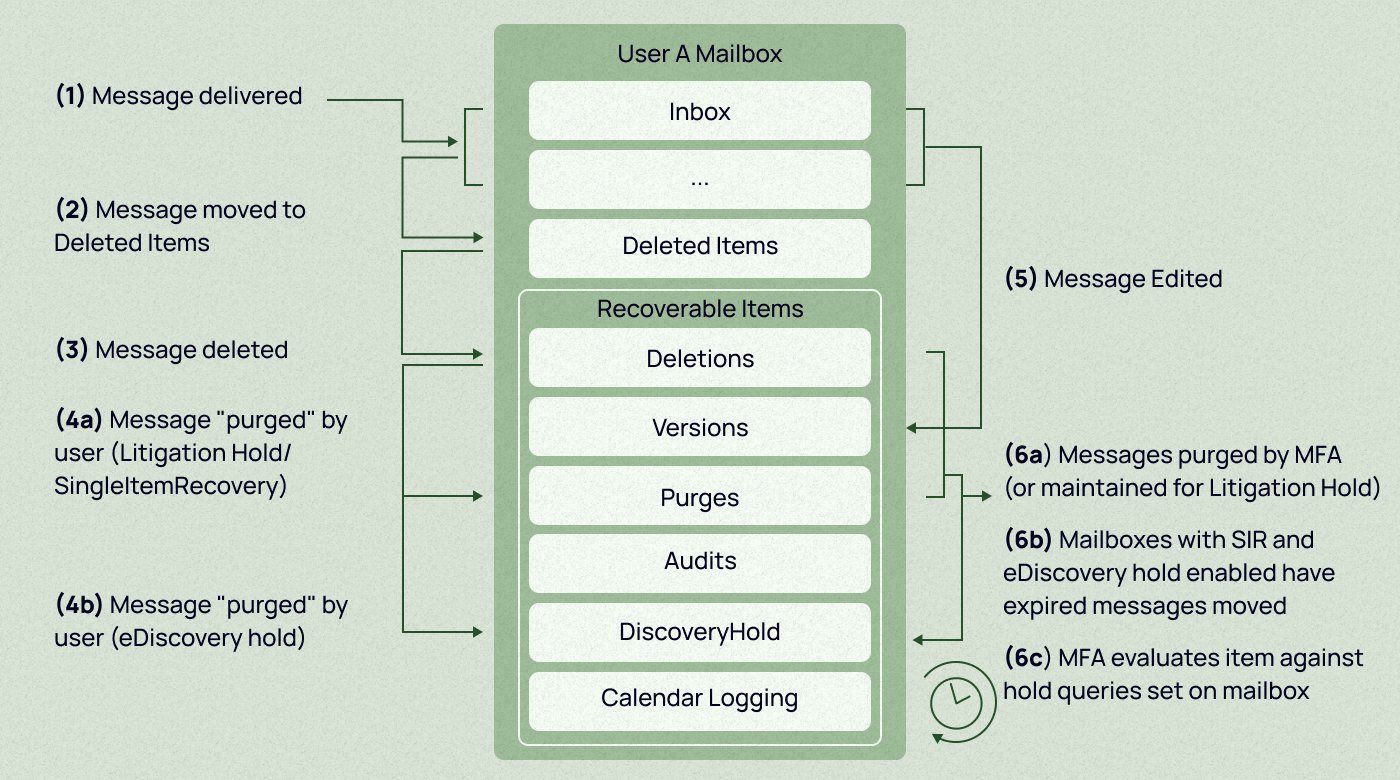
When you have your legal hold notice ready, deliver it straight to your custodians. Ideally, you want to send it via email. Keeping a paper trail to document your compliance is critical to the process. Setting up email confirmations of receipt will make tracking your custodians’ compliance easier.
Creating a legal hold notice may feel like you’re piecing together a complex puzzle. But keeping the notice specific and accessible means you’ll be one step closer to preserving all the data that might be necessary for litigation.
Unresponsive Custodians and Reminder Notices
Sending out legal hold notifications doesn’t mean you’re finished with the process. Unfortunately, some custodians won’t respond. Handling unresponsive custodians is like tracking down elusive witnesses—but having a strategy in hand can help you crack the case.
Send reminder notices. These are your beacons in the silence. But they’re more than just casual “Hey, remember this?” emails. These reminders are essential tools for reinforcing compliance and upholding the integrity of the legal process.
Consider implementing a systematic approach for sending reminders. For example, a bi-weekly reminder might work for most custodians, but you might need to turn up the frequency for perpetual non-responders.
The key is to avoid having the reminders become expected, regular, and not taken seriously. Customize your reminders to specific non-responders. And don’t shy away from having direct conversations with chronic non-responders to stress the importance of the legal hold. Speaking with non-responders face-to-face and requiring them to sign a statement verifying their understanding of compliance might be needed.
With a robust reminder strategy, you can bring unresponsive custodians back into focus and ensure all pieces of the puzzle are in place for your legal investigation.
Ending a Legal Hold
Every case has an end. And in the legal hold process, that’s releasing the hold.
Ending a legal hold notice isn’t just a casual “all clear” signal. Instead, it’s an intentional, well-documented action. It’s a meticulously drafted notice that indicates the legal need for preserving certain data has ended because litigation is no longer “reasonably anticipated.”
Reasons for ending a legal hold are:
- The action is dismissed
- Judgment on the case is ruled
- Statutes of limitations have expired
- A settlement has been reached
In this final notice, don’t skimp on the details. Include the exact date and the reasons for ending the hold. And keep in mind that this isn’t just a formality—it’s your shield against any future accusations of improper handling of data.
Picture this: You issue a release notice stating, “As of May 31, 2023, the requirement to preserve documents related to Project X has ended due to the settlement of the dispute.” It’s clear, it’s concise, and it tells your custodians exactly what they need to know.
Speaking of custodians, don’t forget to inform them directly that their part in the investigative journey is done.
Remember, releasing a legal hold is a vital step. Gathering all the documents is key to a legal hold, but how you wrap up the case is just as important.
Key Considerations for Developing an Effective Legal Hold Notice Policy
Once you’ve completed the legal hold process from beginning to end, you’ll want to look to the future. Prepping a policy for future litigation will save you time and energy down the line.
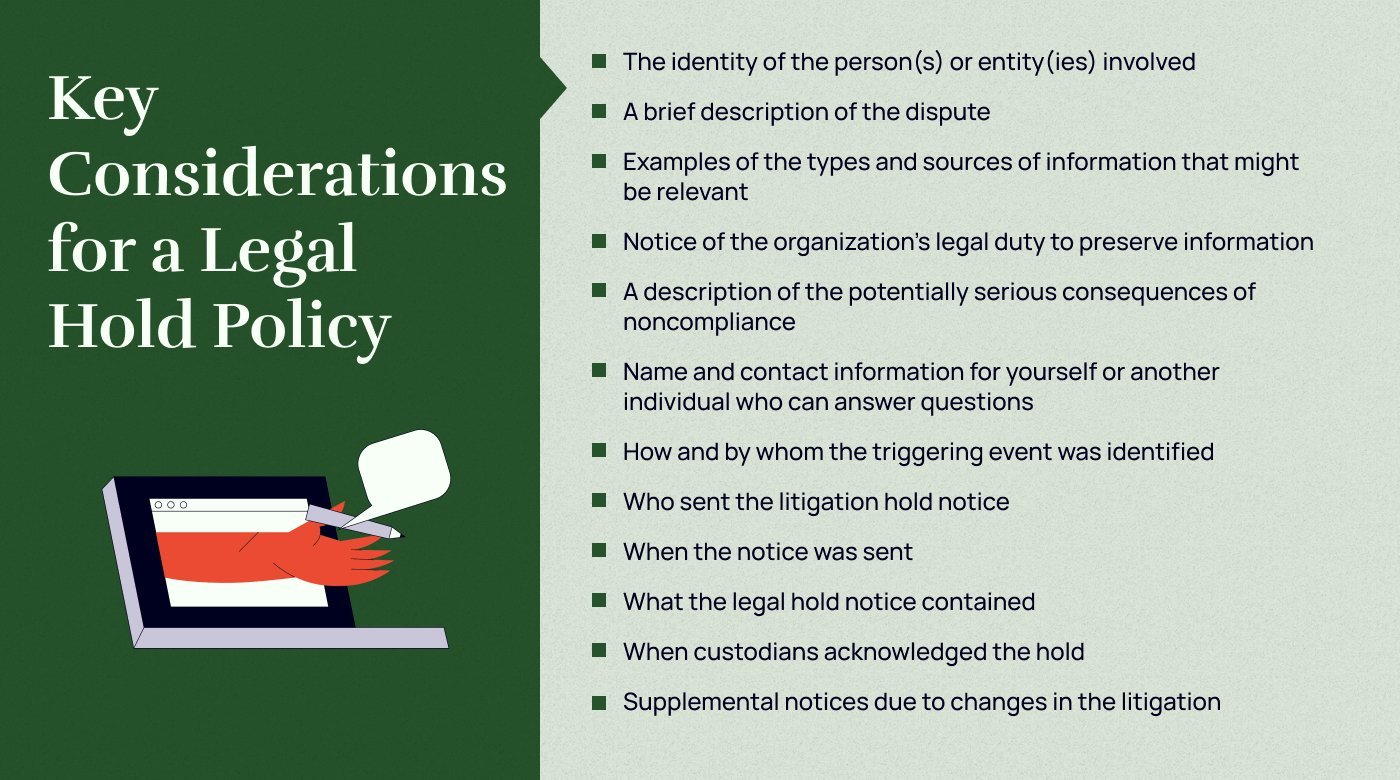
Again, clarity is key for your entire policy. Your policy should lay out each step of the legal hold process in plain language.
Imagine outlining the policy as follows: “Determine the scope of the data that needs to be preserved, and identify the appropriate custodians. Send the initial notice to custodians via email with clearly stated preservation obligations. Follow up every two weeks to ensure compliance.”
Your policy must cover everything from identifying key custodians to defining relevant data types. For example, “Custodians include anyone who has had any involvement with the case, which could range from emails to Slack messages.”
Having a solid policy that includes a wide range of litigation possibilities is key. The specifics for each case will change, and your policy needs to include stipulations for each. It might include provisions such as: “In high-stakes litigation, intensify follow-up reminders to weekly, ensuring custodians remain diligent.”
Your overall policy is an evolving document. It should be updated regularly to incorporate legal changes and operational improvements. Revisit successes and glitches to refine your policy, keeping it both current and effective. With an established policy, you’re set for any legal hold process, no matter what twists the case throws at you.
Overcoming Implementation Challenges of a Legal Hold Notice Policy
As a small law firm, implementing a legal hold notice policy can feel daunting. But don’t worry—there are ways to overcome any challenges you might face.
Here are some tips to set you up for success:
1. Balance Obligations With Budgetary Constraints
Keeping legal obligations balanced with the budgetary constraints of a small firm can be a precarious act to perform. Your obligations include preserving relevant data, promptly communicating hold notices, and making sure all custodians understand their duties.
But despite these challenges, maintaining a balance without hiring scores of paralegals is possible.
Start by adopting a strategic data preservation plan. You’ll no doubt have a mountain of data floating in various places, but not all of it’ll be relevant to the case. Create clear criteria for what needs to be preserved early in the process to avoid becoming overwhelmed. Doing so will allow your team—however large or small it might be—to focus on classifying and prioritizing only the data that’s central to the case.
Once your team knows what needs to be preserved, having a legal hold notice letter template offers a time-saving way to create email notices for custodians.
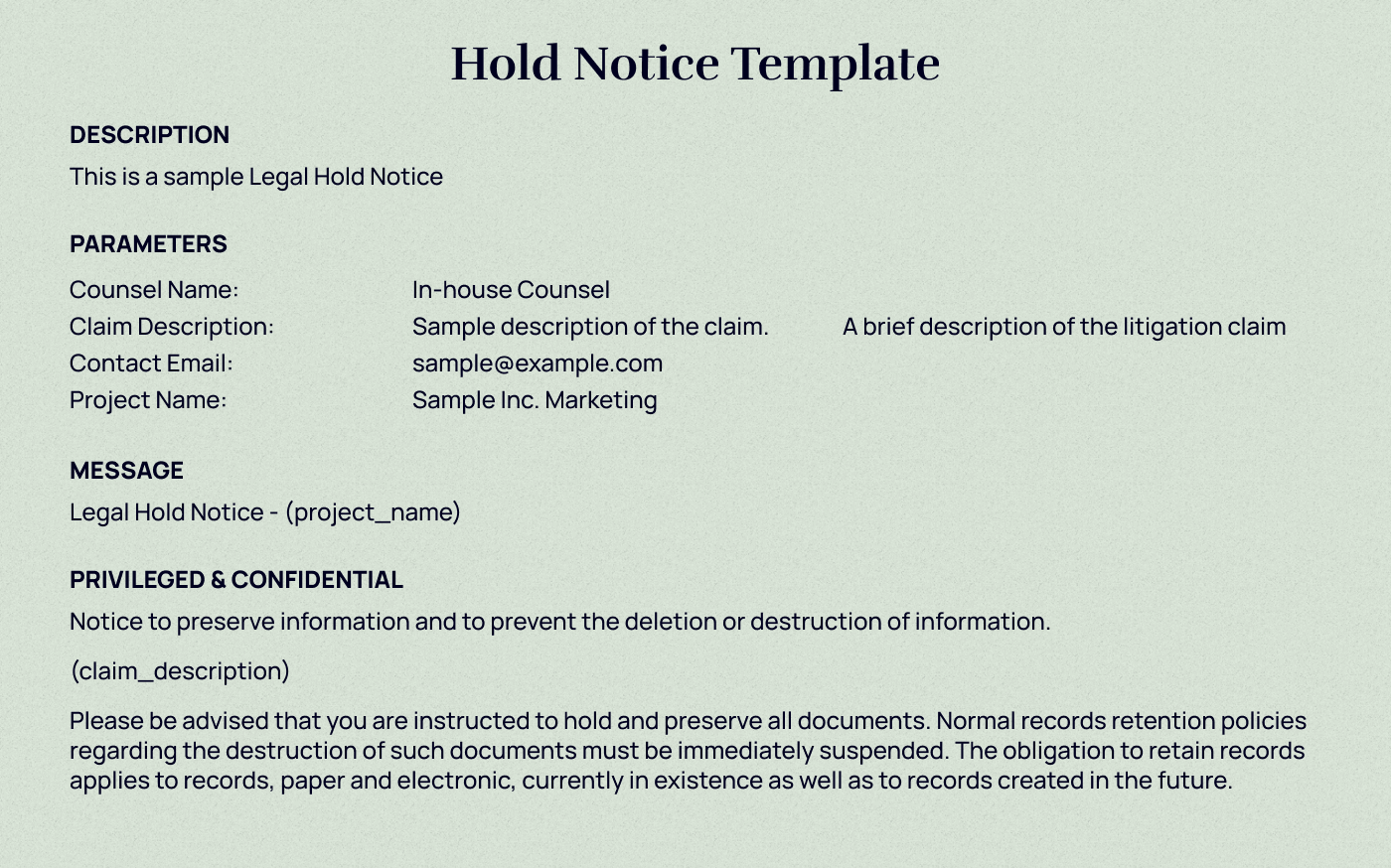
As your team works through the data, diligently track your preservation steps to help satisfy your legal obligations. You’ll demonstrate to the court that you’ve taken reasonable steps to comply, even within your resource constraints.
Even with a small team and limited resources, you can implement a strategic data preservation plan and diligently track your preservation steps to meet legal obligations.
2. Deal With Difficult Employees or Clients Who Refuse to Cooperate
You’ll inevitably come across reluctant employees or clients during the legal hold process.
In these situations, start by building a culture of open dialogue. Encourage employees and clients to discuss any confusion about legal holds and clear up any misconceptions during training sessions. Transparency about the legal hold process can demystify it, making compliance less daunting.
It’s crucial to let everyone know that non-compliance isn’t an option, as it carries tangible consequences. For employees, these consequences might first involve formal warnings, then discussions with superiors, then, finally, termination.
Clients can also face serious consequences for non-compliance. A case could be dismissed, fines imposed, or sanctions placed on clients by the court. In some extreme cases, the court may give an “adverse inference” instruction to the jury, which means the jury can assume the missing information was unfavorable to the client. Lastly, continued non-compliance can strain the attorney-client relationship to the point where you might need to withdraw from the case (following all necessary rules and procedures for doing so, of course).
Having and openly discussing a clear escalation policy helps streamline how you handle non-compliance and keeps your legal hold process on track. Despite the size of your firm, setting the tone from the beginning through consistent training and clear communication is a major step toward scaling up.
3. Ensure Compliance With Regulatory Requirements and Guidelines
Even if you have all parties (employees and clients) actively participating in the legal hold process, you still need to make sure you’re ensuring compliance with regulatory requirements.
Stay on top of changes in the law by regularly scanning legal bulletins, subscribing to relevant newsletters, and even using legal software. These resources can help you ensure your practices are aligned with the latest laws and regulations. Also, consider ongoing training programs for you and your team that reflect recent changes and decisions.
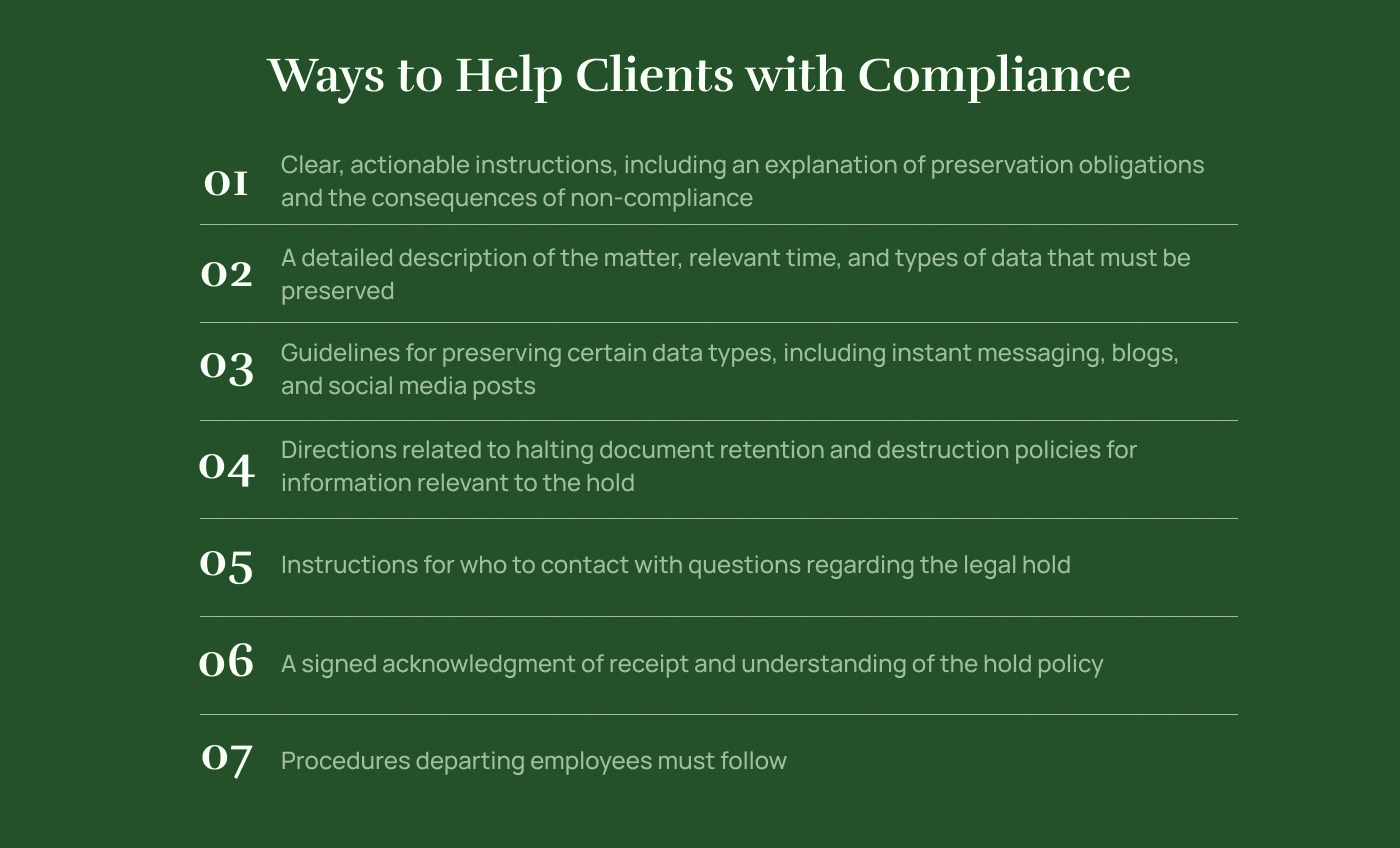
Auditing and compliance reviews aren’t a nice-to-have—they’re a must. An audit isn’t merely a box-ticking exercise, though. It’s about scrutinizing your processes, identifying potential gaps, and creating action plans to address those gaps.
Whether you use a software program or hire out, it’s vital that you regularly revisit and update your legal hold notice policy. With these tactics, you can avoid mismanaging cases, paying fines, and ultimately losing clients.
Powerful Tools to Help Your Organization Meet Its Preservation Obligation
Having an organizational plan for the steps in your legal hold process is a necessity. And tools—both tech and non-tech—can be a significant time-saver.
Let’s look at some of these tools now.
More Articles
Automated Litigation Hold Notices
Manually managing the legal hold process can swamp you with documents and spreadsheets, each one demanding meticulous attention. But with automated solutions, this task becomes more manageable.
Automated systems can identify custodians, dispatch notices, and monitor responses efficiently and accurately. No more burning the midnight oil over manual tracking or slipping up with data due to exhaustion.
Consider the role of auto-reminders in maintaining momentum in your preservation process. People forget—but your automated tool won’t. Auto-reminders offer timely nudges to custodians to ensure they don’t overlook their obligations.
And if you’re looking for more ways to streamline the hold process, technology can enhance collaboration within your team by ensuring transparent, efficient channels of communication.
Technology delivers in terms of secure data management, too. Automated tools provide a safe haven for your data, keeping it intact and accessible and instilling confidence in your clients.
Now, choosing your tech isn’t about snagging the first tool that catches your eye. It’s a meticulous process that requires you to understand your firm’s needs. Your size, the nature of your cases, and your team’s comfort level with tech all matter. A flashy, feature-rich software that requires an IT wizard to operate won’t serve you well if it’s too complex for your team. Instead, aim for tools that offer simplicity, reliability, and robust support.
Scalability is another crucial factor—your tech should grow with your firm.
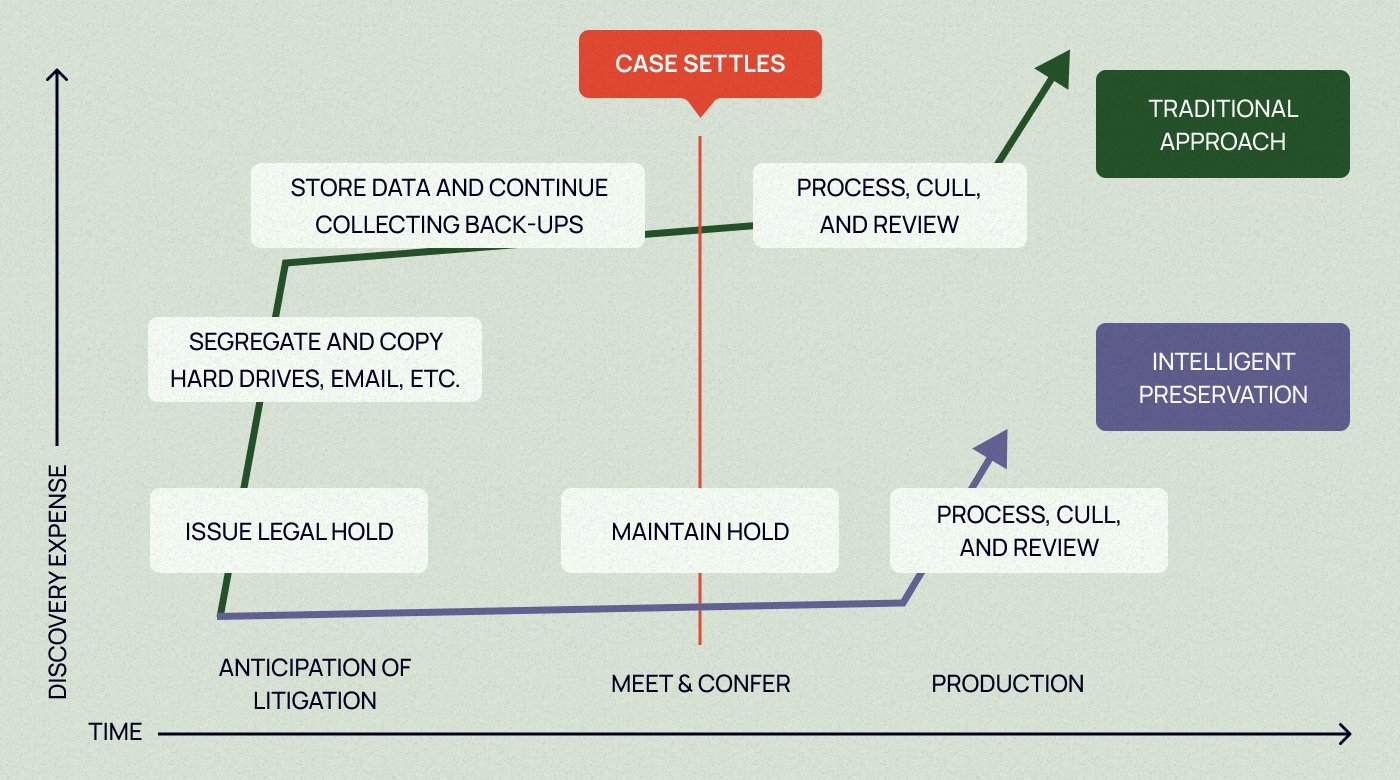
Look beyond the glitter of tech to find a tool that truly meets your needs—one that feels like more of a teammate than a gadget. Check out our carefully curated list of top-notch tech software for small law firms to begin your journey toward a streamlined, tech-empowered legal hold process.
Non-tech Strategies for Streamlining Legal Holds
Effective legal hold management requires a blend of practical strategies, innovative thinking, and a commitment to continuous improvement.
Here are some non-tech strategies that can simplify your legal hold process:
- Clear communication: A solid legal hold process hinges on clear, comprehensive communication. Make sure that every team member understands their role in the process, what’s expected of them, and why their job matters. Demystifying the process can help alleviate common anxieties and foster a more cooperative environment.
- Regular training: Your team shouldn’t neglect legal hold education. Regular training guarantees that everyone stays sharp and is well-versed in any regulatory changes that impact the process.
- Custodian interviews: Consider starting a dialogue with your data custodians, as this exercise can reveal crucial data that may otherwise remain hidden. Maybe there was a sticky note that the custodian didn’t realize was important.
- A visual system: Implement a simple visual system for organizing data. Color coding can be effective; you can designate red for “urgent review needed,” green for “reviewed and preserved,” and so on. This approach keeps data organized and offers at-a-glance insights into task priorities.
- Regular reviews and updates: Your legal hold process needs periodic reviews. Encourage team feedback, and look for ways to make the process more efficient. And update your process as necessary to comply with changes in case law and regulations.
- A culture of compliance: Cultivating a culture of compliance can make a significant difference in how smoothly your legal hold process runs. When team members understand the value and importance of compliance, they’re more likely to follow protocols and contribute positively to the process.
These strategies may seem simple, but their impact can be profound. Blending tech and non-tech approaches helps you create a legal hold process that’s both efficient and effective.
Summary
Legal hold notices can seem complex for small law firms. But with the right information and tools, they don’t have to be.
The real secret is finding the rhythm that works best for your team. For maximum effect, combine that with a smart mix of tech and non-tech strategies.
Subscribe to our newsletter for more industry insights and the latest legal tech to optimize your law practice.


